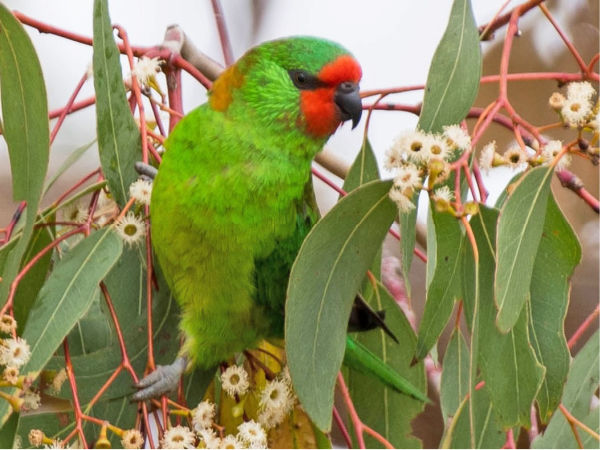 The Little Lorikeet, Glossopsitta pusilla is a small (16-19 cm; 40 g) bright green parrot, with a red face surrounding its black bill and extending to the eye. The undertail is olive-yellow with a partly concealed red base, and the underwing coverts are bright green. The call in flight is a shrill and rolling screech: ‘zit-zit’ or ‘zzet’. Although difficult to observe while foraging high in treetops, a flock’s constantly chattering contact calls give it away. Flight is fast, direct and through or above the canopy. They are nomadic nectar feeders regularly recorded in the Dubbo region.
The Little Lorikeet, Glossopsitta pusilla is a small (16-19 cm; 40 g) bright green parrot, with a red face surrounding its black bill and extending to the eye. The undertail is olive-yellow with a partly concealed red base, and the underwing coverts are bright green. The call in flight is a shrill and rolling screech: ‘zit-zit’ or ‘zzet’. Although difficult to observe while foraging high in treetops, a flock’s constantly chattering contact calls give it away. Flight is fast, direct and through or above the canopy. They are nomadic nectar feeders regularly recorded in the Dubbo region.
Habitat Requirements – Home and Food
- Like other lorikeets, this species forages mostly on flowers, specialising in those growing at the tops of tall eucalypts and paperbarks.
- They feed with other lorikeets, forming noisy mixed-species flocks.
- They forage in the canopy of open Eucalyptus forest and woodland, yet also find food in Angophora, Melaleuca and other tree species.
- Isolated flowering trees in open country, e.g. paddocks, roadside remnants and urban trees, also help sustain viable populations.
- Feeds mostly on nectar and pollen, occasionally on native fruits such as mistletoe, and only rarely in orchards
- Gregarious, travelling and feeding in small flocks (<10), though often with other lorikeets. Flocks numbering hundreds are still occasionally observed and may have been the norm in past centuries.
- Roosts in treetops, often distant from feeding areas.
- Nests in proximity to feeding areas if possible, most typically selecting hollows in the limb or trunk of smooth-barked Eucalypts. Entrance is small (3 cm) and usually high above the ground (2–15 m). These nest sites are often used repeatedly for decades, suggesting that preferred sites are limited. Riparian trees often chosen, including species like Allocasuarina.
- Nesting season extends from May to September. In years when flowering is prolific, Little Lorikeet pairs can breed twice, producing 3-4 young per attempt.
Threats
- Given that large old Eucalyptus trees on fertile soils produce more nectar, the extensive clearing of woodlands for agriculture has significantly decreased food for the lorikeet, thus reducing survival and reproduction. Small scale clearing, such as during roadworks and fence construction, continues to destroy habitat and it will be decades before revegetated areas supply adequate forage sites.
- The loss of old hollow bearing trees has reduced nest sites, and increased competition with other native and exotic species that need large hollows with small entrances to avoid predation. Felling of hollow trees for firewood collection or other human demands increases this competition.
- Competition with the introduced Honeybee for both nectar and hollows exacerbates these resource limitations.
- Infestation of habitat by invasive weeds.
- Inappropriate fire regimes.
- Aggressive exclusion from forest and woodland habitat by over abundant Noisy Miners.
- Climate change impacts including reduction in resources due to drought.
- Degradation of woodland habitat and vegetation structure due to overgrazing.
 The Little Lorikeet, Glossopsitta pusilla is a small (16-19 cm; 40 g) bright green parrot, with a red face surrounding its black bill and extending to the eye. The undertail is olive-yellow with a partly concealed red base, and the underwing coverts are bright green. The call in flight is a shrill and rolling screech: ‘zit-zit’ or ‘zzet’. Although difficult to observe while foraging high in treetops, a flock’s constantly chattering contact calls give it away. Flight is fast, direct and through or above the canopy. They are nomadic nectar feeders regularly recorded in the Dubbo region.
The Little Lorikeet, Glossopsitta pusilla is a small (16-19 cm; 40 g) bright green parrot, with a red face surrounding its black bill and extending to the eye. The undertail is olive-yellow with a partly concealed red base, and the underwing coverts are bright green. The call in flight is a shrill and rolling screech: ‘zit-zit’ or ‘zzet’. Although difficult to observe while foraging high in treetops, a flock’s constantly chattering contact calls give it away. Flight is fast, direct and through or above the canopy. They are nomadic nectar feeders regularly recorded in the Dubbo region.